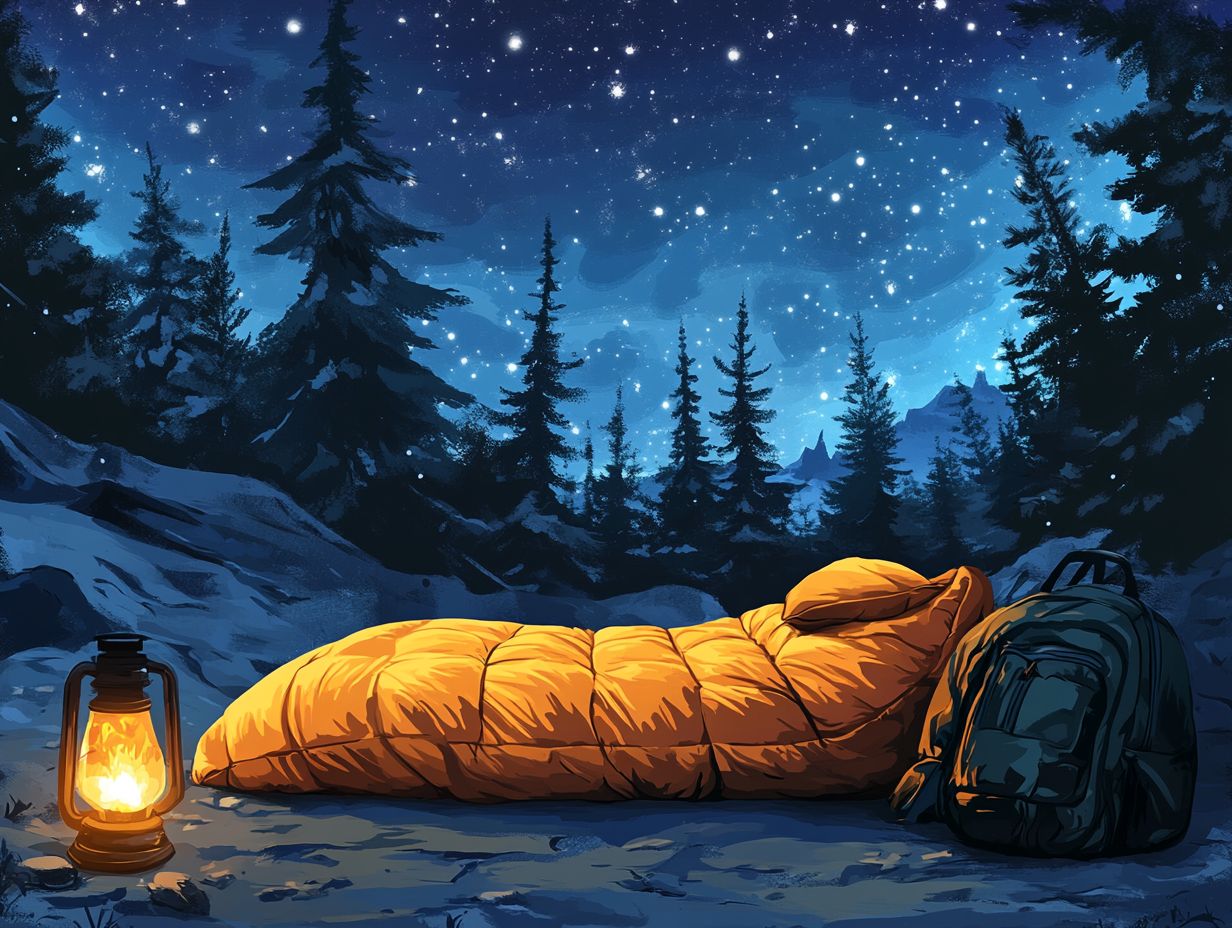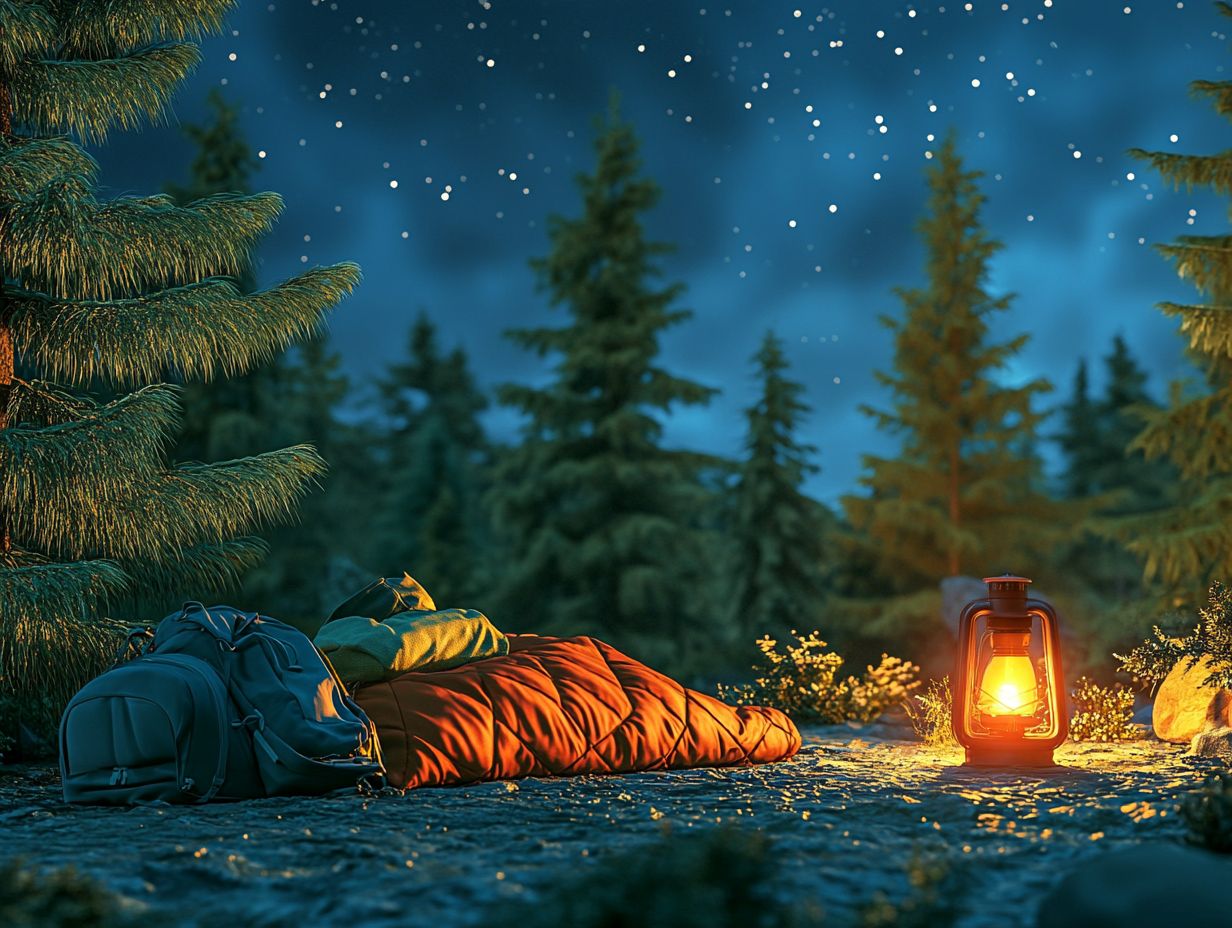When heading out into the great outdoors, having the right sleeping bag can mean the difference between a restful night and a chilly, uncomfortable experience. This is especially true for first-time campers who may not be familiar with the essentials of selecting the best gear.
This guide covers the essentials of sleeping bags, including their importance for camping trips, the various types available, and the best insulation materials to keep you cozy, such as down and synthetic insulations.
It also explores temperature ratings and key factors to consider when choosing the perfect sleeping bag, along with product recommendations to help you decide.
Get ready to enjoy nature without sacrificing comfort! Remember to pack sleeping bags tightly to maximize space in your gear.
Sleeping Bag Basics
Understanding the basics of sleeping bags is essential for both seasoned campers and first-time campers embarking on a camping trip, as they often rely on recommendations for selecting the right gear. A sleeping bag not only provides a cozy retreat at the end of a long day of outdoor adventures, but it also plays a critical role in insulation works that keep you warm during chilly nights, especially in camping cold areas. With various types available, choosing the right one can make a significant difference in your camping experience, especially in cold floor conditions or camping cold areas, where proper insulation and temperature ratings are vital for comfort.
What is a Sleeping Bag?
A sleeping bag is a specialized insulated bedding designed specifically for camping and outdoor activities, providing warmth and comfort during sleep.
This essential gear comprises several layers and features, such as fleece blankets and reflective thermal sheets, that work together harmoniously, ensuring an enjoyable resting experience.
Many sleeping bags utilize synthetic insulations and down materials, each offering unique advantages for various camping conditions. Synthetic insulation provides excellent moisture resistance while maintaining warmth, making it ideal for damp conditions.
On the other hand, down insulation is lightweight and compressible, offering superior thermal efficiency for those who prioritize packability, making it ideal for long trips where weight is a concern.
Comfort is further enhanced by features like draft collars and adjustable hoods, ensuring minimal heat loss. A well-structured sleeping bag is more than just a blanket; it’s a cocoon of warmth tailored to the needs of adventurers venturing into the wilderness.
Why is a Sleeping Bag Important for Camping?
A sleeping bag is crucial for camping trips because it ensures that campers stay warm and cozy even in the most challenging conditions, which is especially important in camping cold areas.
In terms of planning a successful outdoor adventure, the importance of a sleeping bag cannot be overstated. This essential gear not only provides a layer of protection against the cold ground but also traps body heat, creating a warm sanctuary for nighttime rest.
For first-time campers, selecting the right sleeping bag can be overwhelming, given the various options available. Understanding the temperature ratings is key to choosing a bag suited for specific climates and knowing how to care for your sleeping bag, including following the manufacturer’s instructions for proper washing and storage. These ratings indicate the lowest temperature at which the bag can maintain warmth, aiding campers in avoiding cold shocks, especially vital during a winter camping trip in areas like Canyonlands in December.
Without the appropriate sleeping bag, campers risk experiencing discomfort that could lead to disturbed sleep, decreased energy, and even dangerous hypothermia, particularly when temperatures drop unexpectedly. In essence, investing in a proper sleeping bag is not just about comfort; it’s a matter of safety and well-being during outdoor excursions.
- Insulation Types: Down vs. Synthetic
- Factors Influencing Warmth
- Tips for First-Time Buyers
Types of Sleeping Bags
There are various types of sleeping bags designed to meet different needs and preferences, each with unique features that cater to specific camping scenarios and environments.
Rectangular Sleeping Bags
Rectangular sleeping bags are designed for spacious comfort, making them ideal for campers who prioritize roominess during their sleep.
These bags offer ample space, allowing users to move freely without feeling constricted, which is particularly beneficial for those who prefer to sleep in various positions.
They can accommodate additional layers, such as blankets, adding to the overall warmth and coziness during colder nights.
Typical scenarios where these bags excel include family camping trips, where multiple people might share a tent, or casual summer festivals where comfort is key.
For example, the Coleman ComfortSmart model is an excellent choice, featuring extra cushioning and a polyester lining that enhances a peaceful night’s rest.
- Perfect for family outings
- Suitable for summer festivals
- Allows for extra layering
In essence, rectangular sleeping bags provide a blend of comfort and functionality, catering to both seasoned campers and casual adventurers alike.
Mummy Sleeping Bags
Mummy sleeping bags are streamlined and contoured to fit the body snugly, maximizing insulation works and heat retention, making them perfect for cold weather camping.
These bags feature a tapered design that reduces unused space, creating a cocoon-like effect that effectively traps warmth. The shape and size ensure that less air has to be heated, which enhances thermal efficiency. The materials used in mummy sleeping bags, such as high-quality synthetic fibers or down insulation, provide excellent heat retention without adding excessive weight.
- Compared to rectangular sleeping bags, mummy bags deliver superior warmth due to their snug fit.
- They are generally lighter and more compact when packed, making them a great option for backpackers.
- The hood and draft collar design work together to minimize heat loss around the head and neck areas.
All these features combined make mummy sleeping bags an effective choice for adventurers looking to stay warm in extreme conditions.
Semi-Rectangular Sleeping Bags
Semi-rectangular sleeping bags combine the spaciousness of rectangular designs with the insulation benefits of mummy bags, offering a versatile option for campers who value both freedom of movement and decent warmth during cool nights outdoors.
These bags are especially useful for campers who find traditional mummy shapes restrictive, yet still want the thermal efficiency offered by quality insulation. One significant advantage of semi-rectangular options is their ability to accommodate various sleeping positions, making them particularly appealing for restless sleepers or those who prefer a little extra space.
- Enhanced Comfort: With a more generous cut, they allow for better freedom of movement.
- Weight Considerations: While slightly heavier than traditional mummy bags, they often provide a good balance for those willing to trade some weight for added comfort.
- Versatility: Perfect for family camping trips where shared space and flexibility are essential.
In particularly cold conditions, they may not offer the full warmth profile of a dedicated mummy sleeping bag. Therefore, for campers heading into extreme conditions, the trade-offs might warrant re-evaluating their choice.
Double Sleeping Bags
{
Double sleeping bags are designed for couples or friends sharing a camping trip, providing ample space and warmth for two people, making them an excellent choice for creating a cozy environment under the stars. When venturing into the great outdoors, having a sleeping arrangement that allows for additional comfort and warmth is paramount. This type of sleeping bag not only offers generous dimensions but is also crafted with insulation materials that trap heat efficiently, ensuring both parties remain snug throughout the night, even if they need to use hot water bottles or drink warm fluids to stay warm. They are especially beneficial for those who are inexperienced in camping, as sharing body heat can ease the initial chill often felt by newcomers. These bags can eliminate the hassle of managing two separate sleeping setups, making for a streamlined camping experience. Consider using double sleeping bags in various scenarios, such as camping with a partner or during outdoor music festivals where comfort is crucial.
- Weekend camping trips with a partner.
- Outdoor music festivals where comfort is crucial.
- Backpacking adventures where weight and space are at a premium.
“
}
Double sleeping bags are designed for couples or friends sharing a camping trip, providing ample space and warmth for two people, making them an excellent choice for creating a cozy environment under the stars. When venturing into the great outdoors, having a sleeping arrangement that allows for additional comfort and warmth is paramount. This type of sleeping bag not only offers generous dimensions but is also crafted with insulation materials that trap heat efficiently, ensuring both parties remain snug throughout the night.
They are especially beneficial for those who are inexperienced in camping, as sharing body heat can ease the initial chill often felt by newcomers. These bags can eliminate the hassle of managing two separate sleeping setups, making for a streamlined camping experience.
Consider using double sleeping bags in various scenarios:
- Weekend camping trips with a partner.
- Outdoor music festivals where comfort is crucial.
- Backpacking adventures where weight and space are at a premium.
Insulation Materials
The effectiveness of a sleeping bag largely depends on the insulation materials used, which can significantly affect warmth, weight, and packability, highlighting the importance of understanding different materials like down and synthetic sleeping bags.
Down Insulation
Down insulation is renowned for its excellent heat retention and lightweight characteristics, making it a popular choice for campers looking for warmth without bulk, especially when compared to heavier options available.
In fact, many outdoor enthusiasts appreciate how this material compresses tightly, allowing for easy packing in backpacks during long treks or overnight trips. Its ability to trap air effectively creates a barrier against the cold, ensuring a cozy experience even in chilling conditions.
There are some considerations to keep in mind. While the benefits of down insulation are numerous, such as its unparalleled warmth-to-weight ratio and breathability, sleeping bag care can also be a challenge regarding care and price.
- Cost: Typically, products featuring high-quality down insulation can be on the pricier side.
- Care: Proper cleaning and maintenance are required to preserve its loft and insulation properties.
For scenarios like alpine camping or winter backpacking, where temperatures can plummet, down insulation truly shines, especially in places like Kathmandu. Its performance in dry conditions is unrivaled, making it the preferred choice for those who demand the best in thermal efficiency.
Synthetic Insulation
Synthetic insulation is a popular alternative to down due to its moisture resistance and affordability, making it a reliable choice for various camping conditions and preferences, especially when considering activities in humid or wet environments. Many outdoor enthusiasts appreciate this insulation type for its ability to maintain warmth even when damp, unlike down which tends to lose its insulating properties when wet. The cost-effectiveness of synthetic materials can appeal to those on a budget or those who frequently engage in outdoor adventures, where wear and tear can be a significant concern, particularly around places like Canyonlands.
When comparing synthetic insulation and down, several factors come into play that influence a camper’s decision:
- Moisture Resistance: Synthetic insulation excels in moisture-prone situations, such as rainy weather, where down may clump and lose effectiveness.
- Durability: Synthetic materials typically withstand rigorous use, making them suitable for rugged outdoor adventures, while down requires more care and can get damaged easily.
- Cost-Effectiveness: Synthetic options are generally less expensive, allowing budget-conscious campers to invest in quality gear without overspending.
For those planning trips where inclement weather is expected or for activities that involve rough handling, synthetic insulation may be the superior choice. It remains warm and functional even in less-than-ideal conditions, giving adventurers peace of mind.
Cotton Insulation
Cotton insulation is known for its comfort and breathability, offering a cozy option for casual camping trips but may lack in warmth compared to synthetic or down.
While this natural material provides a soft touch that many find appealing, it’s crucial to recognize its unique properties that set it apart from other insulations. For instance, cotton insulation is highly moisture-wicking, meaning it can help keep users dry by absorbing sweat and allowing for airflow.
In colder environments, it might not provide adequate thermal efficiency as other options do, such as synthetic fibers that are engineered for superior heat retention. In these scenarios, drinking warm fluids, like tea, can also help maintain body temperature.
- Breathability: Ideal for moderate climates.
- Comfort: Feels soft against the skin.
- Water absorption: Can lead to dampness in prolonged moisture conditions.
Therefore, when planning your next adventure, consider both the comfort aspects of cotton insulation and the potential challenges it may present in extremely cold or wet scenarios, especially if you plan to camp near a campfire stay warm.
Temperature Ratings
Temperature ratings are crucial for selecting the right sleeping bag, as they indicate the bag’s suitability for different weather conditions and help ensure optimal insulation works.
Comfort Rating
The comfort rating refers to the temperature at which a sleeper can comfortably rest without feeling cold, making it a critical factor in choosing sleeping bags, especially for outdoor enthusiasts looking to enjoy their camping experience to the fullest.
This rating significantly impacts personal comfort and warmth during nights spent under the stars. When selecting a sleeping bag, one should consider various conditions such as altitude, time of year, and personal preference.
For example, in a chilly mountain campsite, a bag with a lower comfort rating ensures that the user stays warm despite the dropping nighttime temperatures. Conversely, in a milder environment, a lighter sleeping bag with a higher comfort rating may suffice, allowing for a more comfortable sleep without overheating.
Understanding the nuances of comfort rating can therefore guide outdoor lovers in making smarter choices, including the importance of emergency heat-ups, by ensuring that they remain cozy and rested, regardless of the setting.
Limit Rating
The limit rating indicates the lowest temperature at which a sleeper can survive in a sleeping bag, highlighting the bag’s insulation works in extreme conditions, thus making it necessary to perform a heat retention test before embarking on a trip.Understanding this rating is essential for ensuring safety and comfort when exposed to chilly environments.
In various outdoor scenarios, the limit rating becomes a critical factor for campers and hikers. For instance, when planning a trip in the mountains during late fall, the night temperatures can plummet unexpectedly, making it essential to use heated clothes. If a sleeper mistakenly chooses a bag that falls short of the necessary limit rating, they may find themselves battling hypothermia despite having adequate clothing.
Similarly, during winter camping trips,
- users might discover that a lower-rated bag leads to restless nights, affecting overall well-being.
- In contrast, a sleeping bag with an appropriate limit rating ensures a good night’s rest, allowing the adventurer to face the challenges of the day.
In emergency situations, such as needing to survive a night stranded in the cold, the limit rating could mean the difference between comfort and a life-threatening risk. Thus, selecting the right gear according to these ratings is paramount for safety in cold conditions.
Extreme Rating
The extreme rating signifies the lowest temperature a sleeping bag can handle while still allowing survival, albeit under less comfort, making it essential for serious camping.
When embarking on adventurous trips, especially in off-season conditions or remote areas, understanding these ratings is paramount. Campers should recognize that in extreme conditions, merely having the right gear is not sufficient; they must also assess their ability to cope with harsh weather.
- For instance, during unforeseen snowstorms or chilly nights in mountainous regions, relying solely on a mild-rated bag may lead to peril.
- Fluctuations in temperature can vary based on altitude and time of year, making it critical to evaluate the extreme rating before heading out.
Ultimately, whether it’s a weekend escape or an extended expedition, being equipped with a sleeping bag that meets the appropriate rating can be life-saving and ensure a more comfortable experience under the stars.
Factors to Consider When Choosing a Sleeping Bag
When choosing a sleeping bag, several factors must be considered, such as temperature rating, insulation material, size and shape, as well as weight and packability, especially for first-time campers who may not know where to start.
Temperature Rating
The temperature rating is one of the most critical factors when choosing a sleeping bag, as it determines how well the bag will perform in different weather conditions and insulation works.
Understanding this rating can make all the difference between a comfortable night’s sleep under the stars or a dreaded night spent shivering in a cold tent. A sleeping bag with a rating suitable for the season and climate conditions ensures that a camper stays warm, allowing for restful sleep.
For instance, three-season sleeping bags are perfect for spring and autumn camping adventures, while winter sleeping bags provide extra insulation in frigid conditions. Likewise, lightweight options designed for summer trips keep one cool during balmy nights.
Selecting the right bag not only affects sleep quality but also overall camping comfort, making it essential for any adventurer’s gear checklist.
Insulation Material
Selecting the right insulation material is essential for achieving the desired warmth and comfort in sleeping bags, with options like down and synthetic insulation offering different benefits, including more loft for insulation.
In terms of finding the most suitable insulation, campers should consider various factors such as budget, weight, and specific temperature needs.
Down insulation is revered for its incredible warmth-to-weight ratio, making it ideal for those who prioritize light packing and extraordinary warmth in chilly conditions. It tends to lose insulating properties when wet, which can be a downside for damp climates.
On the other hand, synthetic insulation has gained popularity due to its moisture resistance and affordability, functioning well even in wet conditions but typically weighing more. It’s advisable to store loosely to maintain its properties.
- Best uses for down: Cold and dry environments.
- Best uses for synthetic: Humid or unpredictable weather.
Ultimately, understanding these variations can help campers choose the right material that suits their adventure needs, including investing in a good tent for shelter.
Size and Shape
The size and shape of a sleeping bag can significantly impact a camper’s experience, especially for first-time campers who might not be aware of their preferences. These factors not only determine how snugly the bag fits around the body but also play a critical role in maintaining warmth during chilly nights in the great outdoors.
Choosing the right sleeping bag involves understanding how size and shape influence comfort and insulation. For instance:
- Rectangular bags offer spaciousness, ideal for those who prefer to move around while sleeping, accommodating various positions.
- Mummy-shaped bags contour closely to the sleeper’s form, enhancing heat retention, making them suitable for colder conditions.
- Women-specific designs often feature extra insulation in the foot area and narrower shoulders, tailored for different body types.
By selecting the appropriate sleeping bag shape and size, campers can enjoy a restful night’s sleep, which is vital for a successful outdoor adventure.
Weight and Packability
Weight and packability are crucial factors to consider when selecting a sleeping bag for a camping trip, as they can affect how easily the bag can be transported, influencing not just the overall comfort but also the enjoyment of your outdoor adventure. Having a lightweight sleeping bag means that it can be carried with minimal effort, making those long hikes less daunting and preserving energy for exploring. Efficient packability ensures that it takes up minimal space in your backpack, allowing for more room for other essential gear. Choosing the right sleeping bag based on these considerations can enhance your camping experience significantly.
When assessing potential sleeping bags, here are some tips to keep in mind:
- Consider Material: Opt for lightweight materials such as nylon or polyester to reduce overall weight.
- Check Temperature Ratings: Make sure the bag provides adequate insulation for the conditions you expect.
- Look for Compression Features: Many modern sleeping bags come with compression sacks to minimize their packed size.
- Test Weight Limits: If possible, weigh the bag before purchasing to ensure it meets your weight criteria.
By prioritizing both weight and packability, campers can enjoy a more comfortable, hassle-free journey, enabling them to focus on the wonders of the great outdoors.
Product Examples and Descriptions
There are numerous sleeping bags available on the market, each designed to suit various camping needs and preferences, from the Coleman North Rim Extreme Weather Sleeping Bag to the Kelty Cosmic 20 Degree Down Sleeping Bag.
Coleman North Rim Extreme Weather Sleeping Bag
The Coleman North Rim Extreme Weather Sleeping Bag is designed for cold conditions, offering exceptional warmth and insulation for adventurous campers, making it a reliable choice for those who wish to embrace the great outdoors even in frigid temperatures.
This sleeping bag features a temperature rating of 0°F, ensuring that users remain cozy and protected against the elements throughout the night. With its synthetic insulation type, it efficiently retains heat while also resisting moisture, an essential quality for both high-altitude treks and winter camping adventures.
Users often highlight their positive experiences when using this product in various scenarios:
- Backcountry camping in snow-covered terrains, where staying warm is crucial.
- Winter hiking trips, where every ounce of insulation can make a significant difference for comfort.
- Emergency preparedness, ensuring that a reliable sleeping option is always available during unexpected weather changes.
The Coleman North Rim shines as a steadfast companion for any cold-weather escapade.
TETON Sports Celsius Regular Sleeping Bag
The TETON Sports Celsius Regular Sleeping Bag is known for its comfort and versatility, making it a popular choice among casual campers.
Its design prioritizes a cozy experience, featuring a soft lining that invites you to sink in after a long day outdoors. With a temperature rating of 20°F (-6°C), this sleeping bag ensures warmth even during chilly nights, making it suitable for late spring through early autumn camping excursions. Users often highlight its spacious interior, allowing for free movement without feeling constricted, which is particularly appreciated during extended trips.
- Ideal for family camping trips.
- Great for backpacking due to its lightweight build.
- Suitable for sleepovers and more casual outdoor adventures.
Feedback consistently praises its durability and the ease of maintenance, as it can be machine washed without losing its fluffiness. The positive reviews reflect its reputation as an exceptional blend of comfort and practicality, making it a staple for outdoor enthusiasts.
Kelty Cosmic 20 Degree Down Sleeping Bag
The Kelty Cosmic 20 Degree Down Sleeping Bag is a favorite among backpackers, thanks to its lightweight design and excellent thermal efficiency.
This sleeping bag features a premium down insulation that provides exceptional warmth without adding unnecessary bulk, making it a top choice for those who prioritize efficiency in their gear.
With a temperature rating of 20 degrees Fahrenheit, it is suitable for three-season camping, easily accommodating adventures from spring to fall.
Many enthusiasts have praised its ability to retain heat, even in chilly conditions, ensuring a comfortable night’s sleep after a long day on the trails.
Ideal for backpacking trips or car camping, the Kelty Cosmic has earned accolades for its durability and user-friendly design, further enhancing its reputation as a must-have for outdoor enthusiasts.
The North Face Cat’s Meow Sleeping Bag
The North Face Cat’s Meow Sleeping Bag is highly regarded for its balance of warmth and packability, making it a reliable companion for adventurous campers, whether they are navigating cool mountain trails or enjoying a serene night under a starlit sky.
This sleeping bag features high-quality synthetic insulation, ensuring that it retains warmth even in damp conditions, which can be a game-changer for unpredictable weather. With a temperature rating of 20°F (-6°C), it serves well in three-season camping trips, keeping users comfortable during chilly nights.
The design is crafted to maximize compressibility, allowing easy storage in a backpack without adding significant weight.
- Durable exterior fabric resistant to abrasions
- Unique zippered pocket for personal items
- Draft collar to prevent warm air from escaping
Given its functional design and warmth, this sleeping bag is perfect for both weekend getaways and longer excursions, enhancing the overall camping experience.
REI Co-op Trail Pod 30 Sleeping Bag
The REI Co-op Trail Pod 30 Sleeping Bag boasts a great comfort rating, making it a fantastic option for three-season camping, offering users a cozy retreat after a day filled with outdoor adventures in varying weather conditions.
This sleeping bag features high-quality insulation, ensuring warmth without excessive bulk, which is perfect for those who value packability while on the trail. Users have expressed appreciation for its light weight and compressibility, making it easy to stow away in a backpack.
- Designed for versatility, the Trail Pod can also be opened up as a blanket for lounging around the campsite.
- Many have praised its durability, with fabric that withstands the rigors of outdoor life.
These characteristics enhance its appeal to both casual campers and seasoned backpackers alike, proving to be a reliable companion during their escapades.
Marmot Trestles Elite Eco 20 Sleeping Bag
The Marmot Trestles Elite Eco 20 Sleeping Bag is designed with sustainability in mind, using recycled materials for its insulation without compromising warmth.
Along with its eco-friendly insulation, this sleeping bag boasts a temperature rating of 20°F, ensuring that campers remain cozy and comfortable even in cooler conditions.
The materials used not only promote environmental responsibility, but they also enhance the bag’s durability and longevity, making it a reliable companion for outdoor adventures.
The unique design features a water-resistant, breathable outer fabric that provides added protection against the elements, while the anatomic hood and comfort-focused design cater perfectly to your needs.
This sleeping bag truly combines eco-conscious thinking with practical functionality, appealing to all who wish to minimize their environmental footprint while enjoying nature.
Sierra Designs Cloud 800 Sleeping Bag
The Sierra Designs Cloud 800 Sleeping Bag is favored by backpackers for its lightweight down insulation and innovative design, ensuring comfort during long hikes.
Designed with temperature regulation in mind, this sleeping bag incorporates a unique blend of materials that enhance breathability while retaining heat during cooler nights. Users appreciate the Cloud 800’s impressive compressibility, allowing for easy packing without sacrificing warmth.
In various camping scenarios, whether nestled in dense forests or exposed mountain sites, this sleeping bag performs remarkably well. Its stylish exterior includes features like draft collars and a cozy hood, which provide extra protection against chilly winds.
To summarize, here are a few highlights:
- Lightweight construction for easy transport, allowing for the use of aluminium bottles for hydration on the go.
- Down insulation for superior warmth
- Innovative design that accommodates different weather conditions
These elements combine to make the Cloud 800 a staple for outdoor enthusiasts seeking both performance and comfort.
Nemo Disco 15 Sleeping Bag
The Nemo Disco 15 Sleeping Bag is known for its spoon shape, allowing for extra comfort and roominess while maintaining warmth.
This innovative design not only enhances comfort but also provides ample space for those who enjoy a bit of freedom to move around while sleeping. The strategic placement of insulation, combined with the unique shape, helps in better heat retention, which is crucial during chilly nights.
- The wider shoulder area ensures adequate space for side sleepers.
- A tapered foot box minimizes weight and effectively traps heat.
- The soft, breathable materials create a cozy atmosphere that makes falling asleep easier.
Altogether, these thoughtful features make the Nemo Disco 15 an exceptional choice for campers seeking warmth and comfort during their outdoor adventures.
Therm-a-Rest Questar 20 Sleeping Bag
The Therm-a-Rest Questar 20 Sleeping Bag blends warmth and lightweight design, making it an exceptional choice for backpacking trips, particularly for those who prioritize comfort without sacrificing mobility during their adventures in the wilderness.
With a temperature rating of 20°F, this sleeping bag is designed to keep users cozy even in cooler conditions, ensuring a restful night under the stars. What truly sets the Questar 20 apart is its unique insulation technology, utilizing a combination of ultralight down and synthetic materials to deliver optimal performance.
- Comfortable Fit: The bag features a contoured shape that minimizes heat loss while providing ample room to move.
- User Feedback: Many outdoor enthusiasts praise it for its balance of lightweight portability and thermal efficiency.
It’s not just a sleeping bag; it’s an investment in a good night’s sleep, making it perfect for both weekend camping trips and longer excursions where every ounce counts.
Mountain Hardwear Lamina Eco AF Sleeping Bag
The Mountain Hardwear Lamina Eco AF Sleeping Bag is designed with eco-friendly insulation, providing warmth and comfort while minimizing environmental impact.
This innovative sleeping bag is crafted using a unique blend of recycled materials, which not only supports environmental sustainability but also offers exceptional thermal efficiency. Its insulation boasts a temperature rating of 20°F, ensuring that campers stay warm even in chilly conditions.
The
- polyester shell
- soft lining
- durable construction
all contribute to its appeal, making it an excellent choice for nature enthusiasts who prioritize both comfort and eco-responsibility.
The Lamina Eco AF is particularly popular among those who seek to reduce their carbon footprint while enjoying the great outdoors, proving that one can indeed embrace adventure without compromising on environmental principles.
Frequently Asked Questions
What is the importance of choosing the right sleeping bag for a camping trip?
Choosing the right sleeping bag is crucial for staying warm and comfortable during your camping trip. The right sleeping bag will provide insulation and protection from the elements, ensuring a good night’s sleep.
What are the different types of sleeping bags available?
There are three main types of sleeping bags: rectangular, mummy, and semi-rectangular. Rectangular bags are more spacious and allow for more movement, while mummy bags are snug and provide more warmth. Semi-rectangular bags combine features of both styles.
How do I determine the temperature rating for a sleeping bag?
Temperature rating is an important factor to consider when choosing a sleeping bag. Look for the EN or ISO ratings, which indicate the lowest temperature the bag can handle while keeping you warm. Keep in mind your own body temperature and the weather conditions of your camping trip.
What material should I look for in a sleeping bag?
Sleeping bags come in a variety of materials, including down, synthetic, and hybrid. Down provides excellent insulation and is lightweight, while synthetic is more affordable and suitable for wet conditions. Hybrid bags combine the best of both materials.
Can I use the same sleeping bag for different seasons?
It is possible to use the same sleeping bag for different seasons, but you may need to adjust your layers and sleeping bag ratings accordingly. For colder seasons, consider using a sleeping bag liner or adding extra insulation layers.
How should I properly care for my sleeping bag?
To care for your sleeping bag, avoid compressing it for long periods of time to maintain its loft and insulation. It’s also advisable to use hanging drying to dry your bag after washing.
To care for your sleeping bag, avoid compressing it for long periods of time to maintain its loft and insulation. It’s also advisable to use hanging drying to dry your bag after washing. Additionally, keep track of the calories you burn during your outdoor activities to stay energized.
It’s important to properly care for your sleeping bag to ensure its longevity and performance. Follow the manufacturer’s instructions for washing and drying, and store it in a dry and cool place when not in use. Avoid compressing the bag for long periods of time to maintain its loft and insulation.







